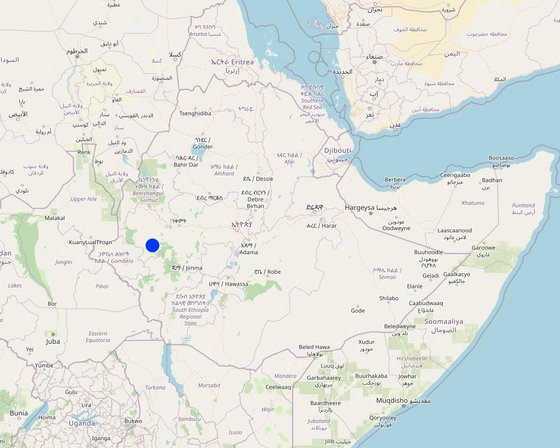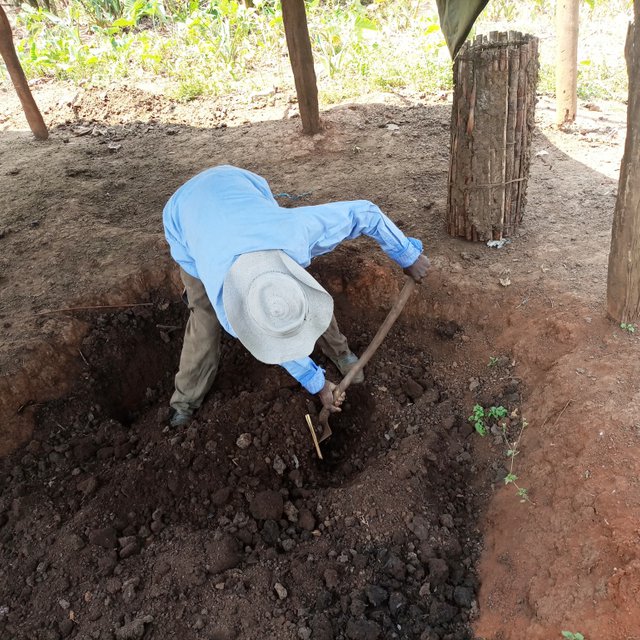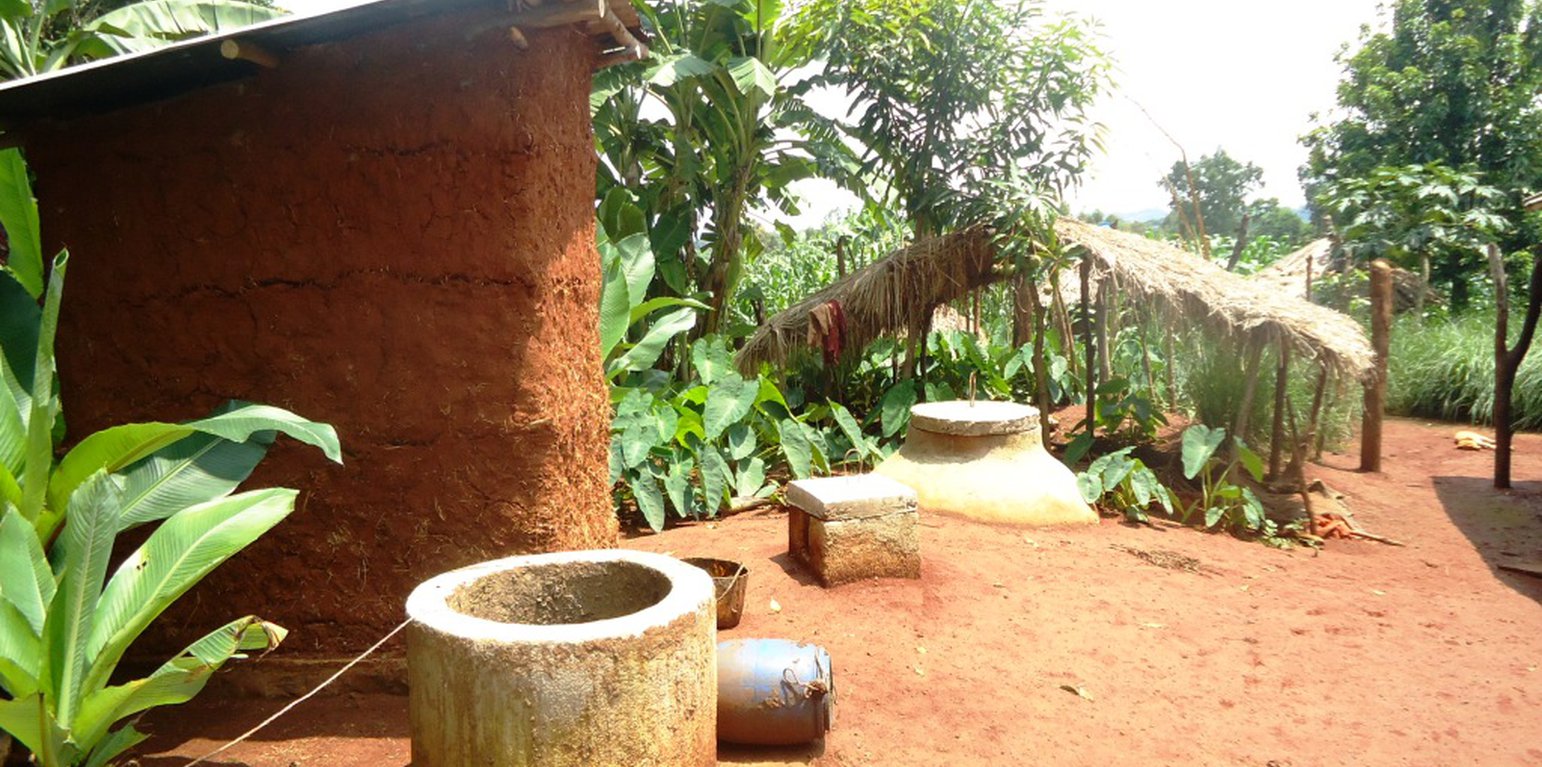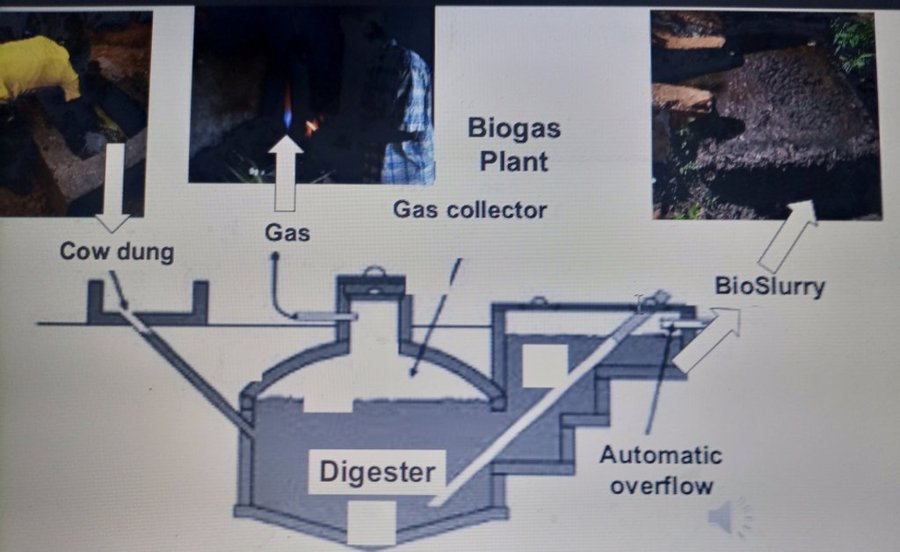Bioslurry
(ប្រទេសអេត្យូពី)
Siico biogaazi
ការពណ៌នា
Bioslurry is a byproduct of the anaerobic process used for production of methane (biogas). It is derived from the manure used to feed the biodigester. Bioslurry is an organic fertilizer that serves as a replacement for chemical fertilizers, and also plays a pesticidal role.
Bioslurry is a byproduct of the anaerobic process used for production of methane (biogas). It is derived from the manure and other organic materials used to feed the biodigester – which is central to a biogas plant. The biodigester is fed with thoroughly mixed livestock manure and water. For instance, a biodigester with a capacity of 8m3 requires manure from 8 cattle mixed with 20 litres of water daily. This allows consistent production of biogas, and bioslurry as a byproduct.
Bioslurry is used as an organic soil amendment that serves as an alternative to chemical fertilizers. It can also play a pesticidal role. Increasing the use of organic fertilizer can reduce the money spent on inorganic fertilizer by at least half. It also improves soil structure via the addition of organic matter. Essentially, the organic matter content of bioslurry is about 20-30%. Appropriate application of the bioslurry as organic fertilizer leads to more moisture retention in the root zone and improves crop resilience to adverse conditions. Usually, bioslurry is applied around homesteads where the biogas plant is sited where it produces energy and light for the household. The main functions of bioslurry are improving soil fertility, increasing crop production, and deterring invasion by various insects. Applying filtered liquid bioslurry to the crop supplies available liquid nutrients and manages crop infestation such as by fall armyworms and maize stalk borer.
Bioslurry is a replacement for chemical fertilizers. It is applied in two forms: liquid and dry forms. The liquid form is mainly used around the homestead, using a watering can or bucket. The dried form can more easily be carried to fields for application. Bioslurry as organic fertilizer is applied to vegetables and other perennial crops around the homestead, once during the growing season. The overall application rate by smallholders is not necessarily based on the recommendation rate per hectare but on the availability of the by-product. Row application is the efficient and effective use of resources in short supply. The rate of application to the specific parcel is on a decremental basis. The end users are pleased by its merit of increasing production, reducing investment costs on chemical fertilizers, improving soil structure and associated properties. They also like the way it makes constructive use of a byproduct that needs to be disposed of. Nevertheless, bioslurry is only available to those who invest in costly biogas plants which also require intensive labour input to collect cattle manure and fetch water.
ទីតាំង

ទីតាំង: Adale-Bise Kebele, Mattu district, Oromia, ប្រទេសអេត្យូពី
ចំនួនទីកន្លែងបច្ចេកទេស ដែលវិភាគ: មួយកន្លែង
ចំណុចយោងភូមិសាស្ត្រនៃទីតាំងជ្រើសរើស
ការសាយភាយនៃបច្ចេកទេស: អនុវត្តនៅកន្លែងជាក់លាក់មួយ/ ប្រមូលផ្តុំនៅតំបន់តូចៗ
តើស្ថិតក្នុងតំបន់ការពារអចិន្ត្រៃយ៍?: ទេ
កាលបរិច្ឆេទនៃការអនុវត្ត: 2020
ប្រភេទនៃការណែនាំឱ្យអនុវត្តន៍៖
-
តាមរយៈការបង្កើតថ្មីរបស់អ្នកប្រើប្រាស់ដី
-
ជាផ្នែកនៃប្រព័ន្ធប្រពៃណី (> 50 ឆ្នាំ)
-
ពេលកំពុងពិសោធន៍
-
តាមរយៈគម្រោង / អន្តរាគមន៍ពីខាងក្រៅ

A farmer composting and drying bioslurry for use in remote farmland. (Gerba Leta)
គោលបំណងចម្បងៗ
-
ធ្វើឱ្យប្រសើរឡើងនូវផលិតកម្ម
-
កាត់បន្ថយ, បង្ការ, ស្តារឡើងវិញនូវការធ្លាក់ចុះគុណភាពដី
-
អភិរក្សប្រព័ន្ធអេកូឡូស៊ី
-
ការពារតំបន់ទីជម្រាល/តំបន់ខ្សែទឹកខាងក្រោមបញ្ចូលជាមួយបច្ចេកទេសផ្សេងទៀត
-
អភិរក្ស/ធ្វើឱ្យប្រសើរឡើងជីវចម្រុះ
-
កាត់បន្ថយហានិភ័យនៃគ្រោះមហន្តរាយ
-
បន្ស៊ាំទៅនឹងការប្រែប្រួលអាកាសធាតុ/គ្រោះមហន្តរាយ និងផលប៉ះពាល់របស់វា
-
កាត់បន្ថយការប្រែប្រួលអាកាសធាតុ និងផលប៉ះពាល់របស់វា
-
បង្កើតផលប្រយោជន៍សេដ្ឋកិច្ច
-
បង្កើតផលប្រយោជន៍សង្គម
ការប្រើប្រាស់ដី
ដីប្រើប្រាស់ចម្រុះនៅលើដីតែមួយ ទេ
-
ដីដាំដំណាំ
- ដំណាំប្រចាំឆ្នាំ: ធញ្ញជាតិ - ពោត, ធញ្ញជាតិ - ពោតសាលី, Wheat
- ប្រភេទដើមឈើធំៗ និងដើមឈើតូចៗ: ផ្លែប៊ឺ
ចំនួនសារដែលដាំដំណាំក្នុងមួយឆ្នាំ: 1
តើជាការអនុវត្តន៍ដំណាំវិលជុំ? បាទ/ចា៎
ការផ្គត់ផ្គង់ទឹក
-
ទឹកភ្លៀង
-
ទឹកភ្លៀង និងប្រព័ន្ធស្រោចស្រព
-
ប្រព័ន្ធស្រោចស្រពទាំងស្រុង
គោលបំណងទាក់ទងនឹងការធ្លាក់ចុះគុណភាពដី
-
ការការពារការធ្លាក់ចុះគុណភាពដី
-
ការកាត់បន្ថយការធ្លាក់ចុះគុណភាពដី
-
ការជួសជុល/ ស្តារឡើងវិញនៃឱនភាពដីធ្ងន់ធ្ងរ
-
ការបន្ស៊ាំទៅនឹងការធ្លាក់ចុះគុណភាពដី
-
ដែលមិនអាចអនុវត្តបាន
ប្រភេទនៃការធ្លាក់ចុះគុណភាពដីដែលបានដោះស្រាយ
-
ការហូរច្រោះដីដោយសារទឹក - Wt: ការបាត់ដីស្រទាប់លើដោយការហូរច្រោះ
-
ការធ្លាក់ចុះសារធាតុគីមីក្នុងដី - Cn: ការថយចុះជីជាតិ និងកាត់បន្ថយបរិមាណសារធាតុសរីរាង្គ (មិនកើតឡើងដោយការហូរច្រោះទេ), Ca: អាស៊ីតកម្ម
-
ការបាត់បង់រូបសាស្ត្រនៃដី - Ps: ការស្រុតចុះនូវសារធាតុសរីរាង្គនៃដី ការពន្លិចដី, Pu: បាត់បង់នូវផលិតភាពជីវៈដោយសារសកម្មភាពផ្សេងៗ
ក្រុម SLM
-
ការគ្រប់គ្រងដោយរួមបញ្ចូលការដាំដំណាំ និងការចិញ្ចឹមសត្វ
-
ការគ្រប់គ្រងជីជាតិដីតាមបែបចម្រុះ
-
បញ្ចូលការគ្រប់គ្រងសត្វល្អិត និងជំងឺតាមបែបចម្រុះ (រួមទាំង កសិកម្មសរីរាង្គ)
វិធានការ SLM
-
វិធានការក្សេត្រសាស្ត្រ - A2: សារធាតុសរីរាង្គ/ជីជាតិដី, A3: ការរក្សាស្រទាប់ដីខាងលើ
-
វិធានការគ្រប់គ្រង - M2: ការផ្លាស់ប្តូរការគ្រប់គ្រង/ កម្រិតអាំងតង់ស៊ីតេ, M5: គ្រប់គ្រង/ ការប្លាស់ប្តូរសមាសភាពពូជ
គំនូរបច្ចេកទេស
លក្ខណៈបច្ចេកទេស
The Photo clearly portrays where the feedstock is added; the biodigester produces methane gas; gas collection and energy production points, and the final collection pits for bioslurry are located. The photo is adopted from W. Critchley PPT presentation. The dimension of the different parts is variable based on the supply of feedstock and financial resources the land users have for investment.
ការបង្កើតនិងការថែទាំ៖ សកម្មភាព ធាតុចូល និងថ្លៃដើម
ការគណនាធាតុចូល និងថ្លៃដើម
- ថ្លៃដើមត្រូវបានគណនា៖ ក្នុងឯកតាបច្ចេកទេស (ឯកត្តា៖ Biogas structure volume, length: Structure with 8m3 digester)
- រូបិយប័ណ្ណសម្រាប់ការគណនាថ្លៃដើម៖ ETB
- អត្រាប្តូរប្រាក់ (ទៅជាដុល្លារអាមេរិក)៖ 1 USD = 53.12 ETB
- ថ្លៃឈ្នួលជាមធ្យមក្នុង ១ ថ្ងៃ៖ 200
កត្តាសំខាន់បំផុតដែលមានឥទ្ធិពលលើថ្លៃដើម
Economic crisis and price volatility of the labor and materials.
សកម្មភាពបង្កើតបច្ចេកទេស
-
Constructing biogas structure (ពេលវេលា/ ភាពញឹកញាប់: Anytime wanted)
-
Supplying feedstock to the digester (ពេលវេលា/ ភាពញឹកញាប់: On dial basis)
-
Collect bioslurry via collection pits (ពេលវេលា/ ភាពញឹកញាប់: when collection pits are filled and try to compost to transport the dry to remote farmlands.)
-
Apply the slurry to the crop or the farm either in liquid or dry forms. (ពេលវេលា/ ភាពញឹកញាប់: During planting and other time of the season depending, on the types of crop.)
ធាតុចូល និងថ្លៃដើមសម្រាប់ការបង្កើតបច្ចេកទេស
| បញ្ជាក់ពីធាតុចូល |
ឯកតា |
បរិមាណ |
ថ្លៃដើមក្នុងមួយឯកតា (ETB) |
ថ្លៃធាតុចូលសរុប (ETB) |
% នៃថ្លៃដើមដែលចំណាយដោយអ្នកប្រើប្រាស់ដី |
|
កម្លាំងពលកម្ម
|
| Labor |
PDs |
10,0 |
200,0 |
2000,0 |
100,0 |
| Technician |
Lump sum |
1,0 |
10000,0 |
10000,0 |
|
|
សម្ភារៈ
|
| PBC, Gate valve, plastic pipes, stove, bulbs |
Lump sum |
1,0 |
6000,0 |
6000,0 |
|
| Spade |
Nnumber |
1,0 |
300,0 |
300,0 |
100,0 |
| Wheel barrow |
Number |
1,0 |
1600,0 |
1600,0 |
|
|
សម្ភារៈសាងសង់
|
| Cement |
ton |
1,0 |
10000,0 |
10000,0 |
|
| Stone |
m3 |
2,0 |
1500,0 |
3000,0 |
100,0 |
| Sand |
m3 |
8,0 |
500,0 |
4000,0 |
100,0 |
| ថ្លៃដើមសរុបក្នុងការបង្កើតបច្ចេកទេស |
36'900.0 |
|
| ថ្លៃដើមសរុបក្នុងការបង្កើតបច្ចេកទេសគិតជាដុល្លារ |
694.65 |
|
សកម្មភាពថែទាំ
-
Labor for collection of livestock drops, supply water, and drying the outputs. (ពេលវេលា/ ភាពញឹកញាប់: Throughout)
-
Maintenance of the malfunctioning structure and supply of biogas accessories. (ពេលវេលា/ ភាពញឹកញាប់: Throughout)
ធាតុចូលនិងថ្លៃដើមសម្រាប់ការថែទាំ
| បញ្ជាក់ពីធាតុចូល |
ឯកតា |
បរិមាណ |
ថ្លៃដើមក្នុងមួយឯកតា (ETB) |
ថ្លៃធាតុចូលសរុប (ETB) |
% នៃថ្លៃដើមដែលចំណាយដោយអ្នកប្រើប្រាស់ដី |
|
កម្លាំងពលកម្ម
|
| Family labor to supply feedstock and collect the product. |
PDs |
365,0 |
|
|
100,0 |
|
សម្ភារៈ
|
| Accessories |
Lump sum |
5,0 |
200,0 |
1000,0 |
50,0 |
| ថ្លៃដើមសរុបសម្រាប់ការថែទាំដំណាំតាមបច្ចេកទេស |
1'000.0 |
|
| ថ្លៃដើមសរុបសម្រាប់ការថែទាំដំណាំតាមបច្ចេកទេសគិតជាដុល្លារ |
18.83 |
|
បរិស្ថានធម្មជាតិ
បរិមាណទឹកភ្លៀងជាមធ្យមប្រចាំឆ្នាំ
-
< 250 មម
-
251-500 មម
-
501-750 មម
-
751-1,000 មម
-
1,001-1,500 មម
-
1,501-2,000 មម
-
2,001-3,000 មម
-
3,001-4,000 មម
-
> 4,000 មម
តំបន់កសិអាកាសធាតុ
-
សើម
-
មានភ្លៀងមធ្យម
-
មានភ្លៀងតិចតួច
-
ស្ងួត
លក្ខណៈសម្គាល់នៃអាកាសធាតុ
Dry season: January to March, and wet season: June to September.
ស្ថានីយឧតុនិយម៖ Mettu
ជម្រាល
-
រាបស្មើ (0-2%)
-
ជម្រាលតិចតួច (3-5%)
-
មធ្យម (6-10%)
-
ជម្រាលខ្ពស់បន្តិច (11-15%)
-
ទីទួល (16-30%)
-
ទីទួលចោត (31-60%)
-
ទីទួលចោតខ្លាំង (>60%)
ទម្រង់ដី
-
ខ្ពង់រាប
-
កំពូលភ្នំ
-
ជម្រាលភ្នំ
-
ជម្រាលទួល
-
ជម្រាលជើងភ្នំ
-
បាតជ្រលងភ្នំ
រយៈកម្ពស់ធៀបនឹងនីវ៉ូទឹកសមុទ្រ
-
0-100 ម
-
101-500 ម
-
501-1,000 ម
-
1,001-1,500 ម
-
1,501-2,000 ម
-
2,001-2,500 ម
-
2,501-3,000 ម
-
3,001-4,000 ម
-
> 4,000 ម
បច្ចេកទេសត្រូវបានអនុវត្តនៅក្នុង
-
សណ្ឋានដីប៉ោង
-
សណ្ឋានដីផត
-
មិនពាក់ព័ន្ធទាំងអស់
ជម្រៅដី
-
រាក់ខ្លាំង (0-20 សម)
-
រាក់ (21-50 សម)
-
មធ្យម (51-80 សម)
-
ជ្រៅ (81-120 សម)
-
ជ្រៅខ្លាំង (> 120 សម)
វាយនៈភាពដី (ដីស្រទាប់ខាងលើ)
-
គ្រើម/ មានពន្លឺ (ខ្សាច់)
-
មធ្យម (ល្បាយ, ល្បាប់)
-
ម៉ត់/ ធ្ងន់ (ឥដ្ឋ)
វាយនភាពដី (> 20 សម ក្រោមស្រទាប់លើ)
-
គ្រើម/ មានពន្លឺ (ខ្សាច់)
-
មធ្យម (ល្បាយ, ល្បាប់)
-
ម៉ត់/ ធ្ងន់ (ឥដ្ឋ)
កម្រិតសារធាតុសរីរាង្គក្នុងដីស្រទាប់លើ
-
ខ្ពស់ (>3%)
-
មធ្យម (1-3%)
-
ទាប (<1%)
ដង្ហើមទឹកក្នុងដី
-
ផ្ទៃខាងលើ
-
< 5 ម
-
5-50 ម
-
> 50 ម
ភាពអាចរកបាននៃទឹកលើដី
-
លើស
-
ល្អ
-
កម្រិតមធ្យម
-
មិនមាន/ គ្មាន
គុណភាពទឹក (មិនបានធ្វើប្រព្រឹត្តិកម្ម)
-
ទឹកពិសារដែលមានគុណភាពល្អ
-
ទឹកពិសារដែលគ្មានគុណភាព (តម្រូវឱ្យមានការសំអាត)
-
ទឹកសម្រាប់តែការធ្វើកសិកម្ម (ស្រោចស្រព)
-
ទឹកមិនអាចប្រើប្រាស់បាន
គុណភាពទឹក គឺផ្តោតទៅលើ៖ ទឹកលើផ្ទៃដី
តើមានបញ្ហាទឹកប្រៃហូរចូលដែរឬទេ?
ការកើតឡើងនៃទឹកជំនន់
ភាពសំបូរបែបនៃជម្រកធម្មជាតិ
ចរិតលក្ខណៈរបស់អ្នកប្រើប្រាស់ដីដែលប្រើបច្ចេកទេស SLM
ទីផ្សារ
-
សម្រាប់ហូបក្នុងគ្រួសារ (ផ្គត់ផ្គង់ខ្លួនឯង)
-
ពាក់កណ្តាលពាណិជ្ជកម្ម (ផ្គត់ផ្គង់ខ្លួនឯង/ ពាណិជ្ជកម្ម)
-
ពាណិជ្ជកម្ម/ ទីផ្សារ
ចំណូលក្រៅកសិដ្ឋាន
-
តិចជាង 10% នៃចំណូល
-
10-50% នៃចំណូល
-
ច្រើនជាង 50% នៃចំណូល
កម្រិតជីវភាព
-
មិនល្អខ្លាំង
-
មិនល្អ
-
មធ្យម
-
មាន
-
មានខ្លាំង
កម្រិតនៃការប្រើគ្រឿងយន្ត
-
ប្រើកម្លាំងពលកម្ម
-
ប្រើកម្លាំងសត្វ
-
គ្រឿងយន្ត/ ម៉ាស៊ីន
នៅមួយកន្លែង ឬពនេចរ
-
នៅមួយកន្លែង
-
ពាក់កណ្តាលពនេចរ
-
ពនេចរ
បុគ្គល ឬក្រុម
-
ធ្វើខ្លួនឯង/ គ្រួសារ
-
ជាក្រុម/ សហគមន៍
-
សហករ
-
មានបុគ្គលិក (ក្រុមហ៊ុន, រដ្ឋ)
អាយុ
-
កុមារ
-
យុវវ័យ
-
វ័យកណ្តាល
-
មនុស្សចាស់
ផ្ទៃដីប្រើប្រាស់ក្នុងមួយគ្រួសារ
-
< 0.5 ហិកតា
-
0.5-1 ហិកតា
-
1-2 ហិកតា
-
2-5 ហិកតា
-
5-15 ហិកតា
-
15-50 ហិកតា
-
50-100 ហិកតា
-
100-500 ហិកតា
-
500-1,000 ហិកតា
-
1,000-10,000 ហិកតា
-
> 10,000 ហិកតា
មាត្រដ្ឋាន
-
ខ្នាតតូច
-
ខ្នាតមធ្យម
-
ខ្នាតធំ
ភាពជាម្ចាស់ដីធ្លី
-
រដ្ឋ
-
ក្រុមហ៊ុន
-
ភូមិ
-
ក្រុម
-
ឯកជន មិនមានកម្មសិទ្ធ
-
ឯកជន មានកម្មសិទ្ធ
សិទ្ធិប្រើប្រាស់ដី
-
អាស្រ័យផលសេរី (មិនមានការកំណត់)
-
ជាក្រុម (មានដែនកំណត់)
-
កិច្ចសន្យាជួល
-
ឯកជន
សិទ្ធិប្រើប្រាស់ទឹក
-
អាស្រ័យផលសេរី (មិនមានការកំណត់)
-
ជាក្រុម (មានដែនកំណត់)
-
កិច្ចសន្យាជួល
-
ឯកជន
ប្រើប្រាស់សេវាកម្ម និងហេដ្ឋារចនាសម្ព័ន្ធ
ការងារ (ឧ. ការងារក្រៅកសិដ្ឋាន)
ផលប៉ះពាល់
ផលប៉ះពាល់សេដ្ឋកិច្ចសង្គម
ផលិតកម្មដំណាំ
The farmer observed a significant increase in crop yield per unit of land post the application of bioslurry. According to the farmer, the yield increment amounts to more than double the harvest that used to be gained via the use of chemical fertilizers.
គុណភាពដំណាំ
A farmer communicated the improvement in the taste of the maize grain harvested from the farmland treated with bioslurry.
ផលិតកម្មចំណីសត្វ
It increases biomass production and feed availability from crop residues.
ហានិភ័យនៃភាពបរាជ័យរបស់ផលិតកម្ម
ការគ្រប់គ្រងដី
According to the land user, tilling the farmland treated by bioslurry is lighter than the other soil. Furthermore, it forms an aggregate that otherwise remains dusty on tillage without the use of organic fertilizer or the bioslurry.
ផលប៉ះពាល់វប្បធម៌សង្គម
សន្តិសុខស្បៀង/ ភាពគ្រប់គ្រាន់ខ្លួនឯង
ស្ថានភាពសុខភាព
អាក្រក់ជាងមុន
ប្រសើរជាងមុន
ចំណេះដឹង SLM / ការធ្លាក់ចុះគុណភាពដី
ផលប៉ះពាល់លើអេកូឡូស៊ី
នីវ៉ូទឹកក្រោមដី/ ដង្ហើមទឹក
Not yet empirically measured.
រំហួត
As it promotes the growth of diverse plant species, it has positive effects on reducing evoration.
វដ្តនៃសារធាតុចិញ្ចឹម/ការទទួលបាន
សារធាតុសរីរាង្គដី/ការបូនក្រោមដី
ការបំភាយនៃកាបូន និងឧស្ម័នផ្ទះកញ្ចក់
ផលប៉ះពាល់ក្នុងបរិវេណ
ទឹកដែលអាចទាញមកប្រើប្រាស់បាន (ទឹកក្រោមដី ទឹក-springs)
លំហូរទឹកថេរនិងទៀតទាត់នៅរដូវប្រាំង (រាប់ទាំងលំហូរតិចៗ)
As the technology is not widely adopted and measured its impact is negligible in this regard.
ទឹកជំនន់ខ្សែទឹកខាងក្រោម (មិនត្រូវការ)
កំណកល្បាប់ខ្សែទឹកខាងក្រោម
Reduces the runoff of soil and water because of good ground cover and high biomass production.
ខូចខាតដល់ស្រែអ្នកជិតខាង
As it arrest the downstream runoff, it reduces the damage it may imposes on the adjacent fields.
ការវិភាគថ្លៃដើម និងអត្ថប្រយោជន៍
អត្ថប្រយោជន៍បើប្រៀបធៀបនឹងថ្លៃដើមក្នុងការបង្កើតបច្ចេកទេស
រយៈពេលខ្លី
អវិជ្ជមានខ្លាំង
វិជ្ជមានខ្លាំង
រយៈពេលវែង
អវិជ្ជមានខ្លាំង
វិជ្ជមានខ្លាំង
អត្ថប្រយោជន៍បើប្រៀបធៀបនឹងថ្លៃដើមក្នុងការថែទាំបច្ចេកទេស
រយៈពេលខ្លី
អវិជ្ជមានខ្លាំង
វិជ្ជមានខ្លាំង
រយៈពេលវែង
អវិជ្ជមានខ្លាំង
វិជ្ជមានខ្លាំង
ការប្រែប្រួលអាកាសធាតុ
ការប្រែប្រួលអាកាសធាតុ
សីតុណ្ហភាពប្រចាំឆ្នាំ កើនឡើង
សីតុណ្ហភាពប្រចាំរដូវកាល កើនឡើង
បរិមាណទឹកភ្លៀងប្រចាំឆ្នាំ ថយចុះ
បរិមាណទឹកភ្លៀងប្រចាំរដូវកាល ថយចុះ
ការទទួលយក និងការបន្ស៊ាំ
ភាគរយនៃអ្នកប្រើប្រាស់ដីនៅតំបន់ដែលបានទទួលយកបច្ចេកទេស
-
តែមួយករណី /ពិសោធន៍
-
1-10%
-
11-50%
-
> 50%
ក្នុងចំណោមអ្នកទទួលយកបច្ចេកទេសនេះ តើមានប៉ុន្មានភាគរយដែលបានអនុវត្តន៍ដោយមិនបានទទួលការលើកទឹកចិត្តជាសម្ភារៈ?
-
0-10%
-
11-50%
-
51-90%
-
91-100%
ចំនួនខ្នងផ្ទះ និង/ឬតំបន់ដែលគ្របដណ្តប់
The technology piloted by three farmers in a kebele.
តើថ្មីៗនេះ បច្ចេកទេសនេះត្រូវបានកែតម្រូវដើម្បីបន្ស៊ាំទៅនឹងស្ថានភាពប្រែប្រួលដែរឬទេ?
ចំពោះលក្ខខណ្ឌប្រែប្រួលណាមួយដែលត្រូវបានបន្ស៊ាំ?
-
ការប្រែប្រួលអាកាសធាតុ/គ្រោះមហន្តរាយធម្មជាតិ
-
បម្រែបម្រួលទីផ្សារ
-
កម្លាំងពលកម្មដែលអាចរកបាន (ចំណាកស្រុក)
សេក្តីសន្និដ្ឋាន និងមេរៀនបទពិសោធន៍
ភាពខ្លាំង: ទស្សនៈអ្នកប្រើប្រាស់ដី
-
Improve soil fertility
-
Increase production per unit of land
-
The process allows for cleaning the environment, as cattle manure and urine are collected and safely disposed of or used as feedstock to the biogas structure.
ភាពខ្លាំង: ទស្សនៈរបស់អ្នកចងក្រង ឬបុគ្គលសំខាន់ផ្សេងទៀត
-
Allows the farm to retain moisture and nutrients, keep the crop vigorous, and become resilient to adverse conditions.
-
It creates employment opportunities for the member of the family farmers.
-
Liquid slurry deters insect pests from the farm and the crop.
ចំណុចខ្សោយ/ គុណវិបត្តិ/ ហានិភ័យ : ទស្សនៈអ្នកប្រើប្រាស់ដីវិធីដោះស្រាយ
-
Labor-intensive technology for its production and application to the farm.
Aware of family members and engaged them in the production and uses of slurry.
ចំណុចខ្សោយ/ គុណវិបត្តិ/ ហានិភ័យ : ទស្សនៈរបស់អ្នកចងក្រង ឬបុគ្គលសំខាន់ផ្សេងទៀតវិធីដោះស្រាយ
-
High initial investment cost.
Provide support via the project as well as relevant government organizations such as water and energy, also through strengthening cost sharing with the end user.
-
As the production per structure is relatively low, the rate and frequency of application have not yet worked out.
Need follow-up, documentation, and defining the right amount and frequency of application to crop and the farm.
ឯកសារយោង
Editors
-
Noel Templer
-
Julia Doldt
-
Kidist Yilma
-
Likissa Kurmana Dufera
-
Tabitha Nekesa
-
Ahmadou Gaye
-
Siagbé Golli
អ្នកត្រួតពិនិត្យ
-
William Critchley
-
Rima Mekdaschi Studer
-
Sally Bunning
កាលបរិច្ឆេទនៃការអនុវត្ត: 7 ខែ កុម្ភៈ ឆ្នាំ 2023
កែតម្រូវចុងក្រោយ: 18 ខែ មេសា ឆ្នាំ 2024
បុគ្គលសំខាន់ៗ
-
Tamiru Tolessa - អ្នកប្រើប្រាស់ដី
ការពណ៌នាលម្អិតក្នុងប្រព័ន្ធគ្រប់គ្រងទិន្នន័យរបស់វ៉ូខេត
ឯកសារនេះត្រូវបានសម្របសម្រួលដោយ
ស្ថាប័ន៖
- Alliance Bioversity and International Center for Tropical Agriculture (Alliance Bioversity-CIAT) - ប្រទេសកេនយ៉ា
គម្រោង
- Soil protection and rehabilitation for food security (ProSo(i)l)
ឯកសារយោងសំខាន់ៗ
-
Bioslurry: A supreme fertilizer. Warnass, L. 2014. ISBN: 978-90-70435-07-3: https://www.academia.edu/83905083/Bioslurry_A_Supreme_Fertilizer
ការភ្ជាប់ទៅកាន់ពត៌មានពាក់ព័ន្ធលើប្រព័ន្ធអនឡាញ












